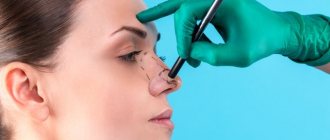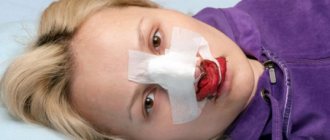Operations to change appearance are akin to the work of a sapper: even an experienced doctor can make a mistake. The numerous star “failures” that the tabloids are full of are the best proof of this. The dangerous aspect of any plastic manipulation is that the real effect cannot be seen immediately, and repeated operations are often required to correct the defects that appear.
Doctors rarely perform such operations for free, for example, for advertising purposes on the central channel. The actual delayed result is the only reason why it was possible to document the unpleasant aspects of plastic surgery
Non-star story
My friend rashly complained about stretch marks after giving birth. When asked what she plans to do about it, the answer was: “Nothing. I’m not a model, why do I need an absolutely perfect body? I love myself, carrying this baby, and my husband loves me like this.”
There are no ideal people; they often love these same imperfections in their loved ones as a unique feature. As you can see, even the excellent work of a surgeon will not bring you happiness if you yourself do not want to become happy and love the real you. And this problem cannot be treated with a scalpel. So go to the mirror right now, look into your eyes and feel how much you love yourself!
Back to the beginning of the article
Don't forget to like and rate the article!
Did you like the article? Subscribe to site updates via RSS, or follow on Twitter, VKontakte, Odnoklassniki, Facebook or Google Plus. And also receive new articles by E-Mail.
Choosing a plastic surgeon and factors influencing the outcome of plastic surgery
IMPORTANT! First of all, you need to understand that the main danger in plastic surgery is not so much the result from an aesthetic point of view, but the safety of the operation itself. Any surgical intervention is a risk: there is a risk of infection, intolerance to anesthesia or other allergic reactions.
The safety of the intervention itself does not depend on the doctor alone. It also depends on factors such as the availability of an intensive care unit, the competence of the anesthesiologist and the entire staff as a whole. Even such things as the organization of the operating room and cleaning play a huge role during surgical interventions. For example, in England, since private firms began cleaning the blocks, the number of infections and infections has doubled.
Infection, suppuration, infection, rejection of the implant, inflammation, allergic reactions to drugs. Most of these complications appear during surgery or within the next three days. This is why the first three days after surgery are very important, and the patient must be under the supervision of medical staff in order to respond in time if a problem arises.
After about a week, the first result is assessed. Despite the fact that the final result will be visible months later, the doctor will be able to detect severe asymmetry or local hematoma (suppuration) within a week.
The doctor must accompany the patient directly to the final result. This does not mean that he will be at your disposal every day in order to answer all the questions that randomly come to you during the day. This means that he will monitor you daily for three days after the operation, then he will examine you after a week, and after that, a month or a year later, depending on the procedure performed, a final consultation will take place.
IMPORTANT! Not all complications depend only on the doctor. The anesthesiologist is responsible for the absence of allergic reactions to drugs, which is why consultation with an anesthesiologist before surgery is mandatory.
Infections are also not entirely dependent on the clinic and doctor; it may be an individual factor. Simply put, you may already have a dormant virus that will manifest itself in an organism weakened by the operation. Many patients know this and begin to blame the doctor or self-medicate themselves with antibiotics before and after surgery. This is a mistake, since antibiotics destroy not only pathogenic bacteria, but also beneficial ones that contribute to recovery. Thus, you can do more harm than good.
Moreover, overuse of antibiotics leads to increased sensitivity of the body and also destroys its natural ability to fight bad bacteria and germs. This explains why those who are overly “afraid” for their health and abuse various kinds of pills and medical procedures often become victims of various “sores” and health problems.
Mistake #5: Mask effect
In his youth, Mickey Rourke was one of the most attractive Hollywood actors. To maintain his status as a sex symbol, he began to take a serious interest in cosmetology and plastic surgery. This hobby led to Mickey Rourke having several lifts, correcting his cheekbones and changing the shape of his lips, which is why his face lost its natural proportions.
Now Mickey Rourke’s face rather looks like a motionless mask, and hardly anyone would call the actor himself even just handsome.
We minimize the risks of unsuccessful plastic surgery
To minimize the risks of unsuccessful surgery, you need to follow all the doctor’s recommendations. Avoid drinking alcohol for several weeks before surgery. If necessary, treat the functioning of organs and strengthen the immune system, and also stop smoking, because it negatively affects wound healing.
When consulting with a surgeon, answer the questions posed accurately. Do not try to hide information, because this can result in negative consequences not only for your beauty, but also for your health.
If this has already happened and the plastic surgery was done unsuccessfully, wait a few months. As a rule, all negative symptoms disappear on their own during this period. In case of long-term unpleasant consequences, repeated surgery will be required.
During the rehabilitation period:
- do not use decorative cosmetics;
- do not visit the sauna or solarium;
- avoid intense physical activity;
- follow a diet;
- do not massage or peel your face;
- treat the skin with antiseptic agents and ointments for swelling or hematomas prescribed by the doctor;
- Do not stay in the sun for a long time.
Listen to all the doctor’s recommendations, and then the risk of serious complications will be significantly reduced.
Elena Proklova
The star of the films “They are calling, open the door”, “The Snow Queen”, “Dove” and former TV presenter of Channel One Elena Proklova does not hide her passion for plastic surgery. The actress resorted to plastic surgery for the first time to correct the shape of her nose.
Rhinoplasty turned out to be successful, and Elena decided to improve her entire face. Lip fillers, a facelift and Botox injections - and Proklova has changed. Her face has lost its zest, for which both directors and spectators once loved the actress.
Melanie Griffith
Antonio Banderos' ex-wife Melanie Griffith is guilty of excessive visits to plastic surgeons. Melanie’s face seems to say: “Don’t repeat my mistakes!” The actress's appearance was the envy of millions: blue eyes, white curls and a wide smile. Despite this, the star decided to undergo rhinoplasty. The idea to slightly correct the tip of the nose failed: instead of a neat bridge, Melanie got a terrible result.
A few years later, she pumped up her lips, cheekbones and had a facelift, which she had no intention of stopping. The result is a break in a marriage that lasts almost 20 years and a face that resembles plasticine. The daughter of Griffith and Banderas, Dakota Johnson, known from the film “50 Shades of Gray,” is a copy of her mother in her youth. We hope she doesn't repeat her mistakes and end up in the tabloid headlines as a victim of plastic surgery.
Rhinoplasty
What is this? Surgery to reshape the nose.
Typical problems. It is most difficult to correct the consequences of those operations during which the surgeon overdid it, that is, he removed too much cartilage and bone tissue. A clear example of this is Michael Jackson, whose nose was simply “narrowed” by experts. The body can respond to such abuse with a so-called bone callus, which is formed as a result of increased calcification.
Another serious mistake is excision of an excessive amount of skin outside and inside the wings of the nose. This leads to impaired nasal breathing and the formation of rough scars.
How they are corrected. If the nose has “failed”, it can be built up. Various implants are used for this. These are special types of silicone or cartilage tissue that is usually removed from the patient's ear. If the manipulations are carried out with the utmost care, only you will know about the defect of the previous operation.
Scars are more difficult to get rid of. The problem is that each body “scars” in its own way, so there is no ideal treatment. As a rule, scars are excised with a laser, or a course of injections of absorbable drugs is prescribed.
Content
- 1 How it started
- 2 Favorite “proof” of evolution
- 3 Surgeons get back to work
- 4 “These organs are useless”
- 5 Killer statistics
- 6 What are its results?
- 7 To be continued?
- 8 Literature
- 9 Taken
How it started
At the very end of the 19th century, the French physician Franz Glenard had a “brilliant idea”: if our distant evolutionary ancestors walked on four legs, then the location of the organs of the digestive system in the human body should not fit well with our current upright gait. Glenard devoted about thirty scientific articles to this idea. After this, the surgical stage of bringing the idea to life began. Patients who complained of abdominal pain, disorders and other ailments of the digestive system were offered a sophisticated operation, the purpose of which was to make certain changes in the “configuration” of the gastrointestinal tract [Taylor, 2000, p. 301]. After this operation, the patients’ problems with their digestion, as a rule, worsened, but their complaints could no longer stop the surgeons, passionate about the evolutionary idea.
The next stage on this path was the idea that arose in the very first years of the twentieth century about the slow poisoning of the human body by the waste products of putrefactive bacteria located in its cecum, which, as evolutionists believed, had largely lost its original functions in humans. “Macroevolutionists have suggested that man evolved from a creature whose cecum was much larger. They believed that this large cecum then shrank and lost its function as a digestive organ, becoming in modern humans a much smaller cecum with an appendix” (Bergman and Howe, 1997, p. 49). The popularizer of the evolutionary idea, writer Isaac Asimov , in his book The human body: its structures and operation (1963, p. 243) wrote the following about this: “What is left to man from the cecum (inherited from a possible herbivorous ancestor) has no particular benefit and can sometimes cause trouble” (cited: ibid., p. 49).
Ilya Ilyich Mechnikov , made a significant contribution to the development of these ideas . Mechnikov believed that the human digestive system, which had developed at the previous stages of its evolution, was poorly adapted to the diet of a civilized person. Inspired by Metchnikoff, the English surgeon William Lane began to implement these ideas.
Lane initially performed surgery to correct “nature's mistake” by changing the junction of the small intestine with the large intestine. But that was only the beginning. Next, he began to remove the entire colon, believing that this operation, freeing the body from putrefactive bacteria located there, would help treat a number of diseases, starting with duodenal ulcers and ending with schizophrenia. Lane performed over a thousand such operations , and his followers - dozens of other surgeons - as the researchers write, left “an uncountable number of victims,” including the dead. Only in the thirties did critical notes about the activities of the followers of Glenard and Mechnikov-Lane begin to appear in medical textbooks. Surgical practice of this kind continued until the fifties - while those who at one time began to engage in it so enthusiastically were alive.
But all this may seem like insignificant episodes in comparison with the problem of the so-called “vestigial organs” that grew out of evolutionism. This problem captivated the minds of gullible surgeons for many decades.
Favorite “proof” of evolution
The word “ rudimentary ” translated from Latin has the following meanings: rudimentary, underdeveloped, disappearing, residual. And to this kind of formations, biologists attributed those anatomical structures that, in accordance with Darwin’s teachings, were inherited by man from his distant evolutionary ancestors, while losing their original functions and becoming useless for man , or at least “requalified” for other functions.
It must be said that back at the beginning of the twentieth century, the list of “vestigial organs” was much wider than in modern textbooks. It consisted of approximately 180 organs and anatomical structures. These, in particular, included such vital anatomical structures as the thymus (thymus gland), pineal gland (pineal gland), tonsils, and knee menisci. According to Professor David Menton , if scientists were unable to determine the function of an organ in the body, it was considered a vestigial. “It is therefore not surprising,” emphasizes Professor Menton, “that with the growth of scientific knowledge and research, the list of such organs has become smaller and smaller.” Currently, many scientists believe that it is time to completely abolish this list.
The researchers of this problem, Professor Jerry Bergman and Dr. George Howe , write: “Scientists have discovered that most of the so-called “rudiments” perform not just one, but several important functions. Some of them come into operation only at certain moments in the life of the organism, for example in critical situations, some work only at certain stages of the development of the organism. But information about this, the researchers emphasize, is practically not included in reference books and textbooks on biology and in books on the origin of life. For example, back in the twenties they wrote about the important functions the semilunar fold located in the corner of the eye performs, and yet some authors of scientific works classify it as a rudiment” - they consider it a remnant of the “third century” - that nictitating membrane that is well developed in birds and reptiles. This fact looks especially paradoxical against the background of the information obtained by science about the “maintenance” of the blinking membrane of reptiles (as well as birds) and the semilunar fold of humans by different nerves, which indicates the impossibility of the existence of any historical connection between these anatomical structures.
Surgeons get back to work
However, the semilunar fold has never been an object of special professional interest for surgeons. Much less fortunate in this regard are some other “vestigial organs” - for example, the coccyx, which in modern textbooks on general biology is often called the “remnant of a reduced tail.” However, research has shown that the coccyx serves as an important attachment site for certain pelvic muscles: “the three to five small coccygeal bones are undoubtedly part of a large supporting system consisting of bones, ligaments, cartilage, muscles and tendons.” So “if the coccyx and its associated muscular system did not exist, people would need a fundamentally different system of support for internal organs.” It took time and an analysis of the consequences of a number of operations for doctors to understand that the removal of the coccyx and other similar interventions in the harmonious system of the human body are far from harmless. “Remove it,” wrote one researcher on this problem, “and patients begin to complain; indeed, operations to remove the coccyx have repeatedly become fashionable and have once again confirmed their bad reputation; only naive surgeons who believe what biologists tell them about a useless “rudiment” revive this operation.”
The same can be said regarding the appendix . It is now known that the appendix “plays an important role in the functioning of the human immune system.” It is a widely known fact that the appendix is made up of lymphatic tissue, so “it helps the human body fight infections, especially in the first years of life.” The researchers note that “the location of the appendix near the junction of the small and large intestines protects the small intestine from bacteria inhabiting the cecum.” In addition, the appendix also performs some other functions. And, finally, it is impossible to trace an “evolutionary line” in which this organ would gradually lose its importance: “the appendix is found in both carnivores and omnivores.”
A similar picture is observed when considering the problem of tonsils and adenoids , which were also considered “rudiments” for a very long time. Only over time it became clear that “tonsils are necessary for a growing body in order to help launch a protective mechanism that produces antibodies that cleanse the body of infection. When this mechanism has already started working, the tonsils shrink almost to the point of complete disappearance, as is the case in adults. Then other organs take over their functions.” Research Williams expresses the general opinion of doctors that “removal of the tonsils is justified only if the tonsils themselves become a constant source of infection instead of protecting the body.”
However, representatives of medicine did not always have this opinion about the importance of tonsils in the body. To understand the atmosphere that has developed among surgeons “enlightened” by the evolutionary idea, it is appropriate to cite one incident that happened to Professor Jerry Bergman - one of the authors of the book “vestigial” organs - when he was only five years old.
“These organs are useless”
“The Bergman family doctor, paying attention to the boy’s habit of breathing through his mouth, suggested removing both his adenoids and tonsils. One of the arguments in favor of removal sounded something like this: “It’s better to do it while he’s still a child; when he grows up, it will be more difficult to do it.” When asked why this should be done at all, the doctor replied: “They are completely useless, so you need to get rid of them, and the sooner the better.” The amazed Bergman asked a question, quite understandable in such a situation, how these tonsils and adenoids got into the throat and what they are needed there for. The doctor repeated: “We are born with them, but they do no good.” The answer was devastating, and five-year-old Bergman could not understand why a person needs an organ that does not bring any benefit.”
In this situation, as is easy to understand, there was a collision of two opposite worldviews - the naive ideas of a five-year-old boy about the expediency of the world order, behind which the contours of faith in the Creator of the world can be seen, and the doctor deceived by evolutionary fables. At the same time, objective scientific data, obtained both through the painstaking work of researchers and the bitter experience of the victims of evolutionary-minded surgeons, testifies against such evolutionary logic: “all organs of the human body work in harmony ,” testifying to the Creator’s plan. Looking at the human body through the prism of the achievements of modern science, one can see in it “not evolutionary wanderings, or mistakes, or random whims, but evidence of the power of His mind and skill.”
Killer statistics
However, during the period of special enthusiasm for Darwinian ideas, everything was exactly the opposite: “rudimentary” tonsils and adenoids were unjustifiably removed from tens of millions of people. As American authors note, in the United States, “in the thirties, the tonsils and adenoids were removed from more than half of the children . Later, however, one famous American pediatrician admitted that “among the million US residents whose tonsils were removed, 999 thousand did not need it . However, the job was done.
What are its results?
Statistics showed that the number of colds and other infections of the pharynx and upper respiratory tract in children with tonsils removed did not differ significantly from this indicator in children who avoided this operation. But, on the other hand, the staff of the New York Cancer Service soon concluded that people with removed tonsils are almost three times more likely to be susceptible to certain malignant diseases . The same tendency to cancer is observed in people with a removed appendix. Thus, after examining several hundred patients with various forms of cancer, it turned out that “in 84% of the examined patients the appendix was removed... In the control group, where there were no cancer patients, only 25% had no appendix.”
To be continued?
Against the background of these figures, it is very instructive to look at modern biology textbooks - the most widespread of them.
So in the textbook “General Biology” edited by Corresponding Member of the USSR Academy of Sciences, Professor Yu.I. Polyansky (the 28th edition of this textbook was published in 2000), the problem of “rudimentary organs” is raised on pages 59-60, where the “vestigial appendix” is given along with other classic examples from the same series - the coccyx and the “rudiment of the third century”. In a similar textbook edited by academician D.K. Belyaev, professor G.M. Dymshits and Professor A.O. Ruvinsky (the 9th edition of this textbook was published in 2000), the appendix has already been excluded from the number of “rudiments” . But it does talk about special muscles that allow “some people to move their ears and scalp” (p. 217) - those muscles of the outer ear that, according to researchers, “are needed to provide the organ with increased blood circulation, thus reducing the risk of frostbite " And with all this, the latest textbook gives valuable instructions on how to treat all the “vestigial organs” listed in it. “Some organs or their parts,” it is written on page 153 of this textbook, “do not function in adult animals and are superfluous for them - these are the so-called vestigial organs or rudiments.” After a few dozen pages, the same approach to “rudimentary organs” is transferred to you and me: “All these organs are useless for humans” (p. 217). Perhaps this thought will push some of the future surgeons to new exploits in due time.
So how to choose a plastic surgeon so as not to regret it later?
The answer is a little prosaic, but it is the most correct. Trust is the key to successful results. After assessing objective factors such as education, work experience, examples of work and the institution in which the doctor practices, you must be able to trust him from A to Z, because by going into surgery with fears and uncertainty, you are emotionally preparing yourself for failure, and then You will look for it on a subconscious level.
Remember, you are not a doctor; a doctor has decades of training and practice behind him. Moreover, scientists have identified a connection with a low level of education and the desire to clearly intervene in the medical process and control the actions of the doctor. Sometimes it just ends in absurdity when a patient comes to a doctor with a diagnosis and asks him to prescribe this or that treatment.
If the doctor is not a paternalist and follows the patient’s demands, warning him in advance about the consequences, then in case of problems the patient forgets the moment that he prescribed the treatment for himself and blames the doctor for everything. If you do not trust the doctor, refuse to operate with him, even if you do not have objective reasons to consider this doctor a bad specialist, this way you will save both yourself and the doctor from subsequent torment.
Poor quality work and dishonesty of the surgeon
How often do plastic surgeons openly deceive their patients, without warning in advance about possible complications, hiding the realities in order to persuade the patient to undergo surgery, taking advantage of the patient’s defenselessness and ignorance.
Partial list of plastic surgeon misconduct:
- Excessively feigned and artificial popularity. A surgeon is first and foremost a doctor, but not a star.
- Marketing approach to medicine, such as giving fancy foreign names to common procedures and making up differences that are intended to mislead to improve sales
- Innovation. Time-tested innovative methods carry many risks for the patient
- The doctor devotes insufficient time to the patient to clarify any questions that have arisen. The surgeon is obliged to provide all the necessary information, taking into account the risks and possible complications.
- Hiding the truth from a patient about his health status
- Refusal to provide explanations to the patient after surgery
- Refusal to do retouching for free
Note: This list is correct for France and is subject to French law
Attention! In plastic, and especially reconstructive surgery, several interventions may be needed to achieve the desired result, but the doctor must warn about this before the operation. Otherwise, if the result does not suit the patient, it is considered a retouching, an adjustment, the doctor should not charge a fee for performing the retouching.









